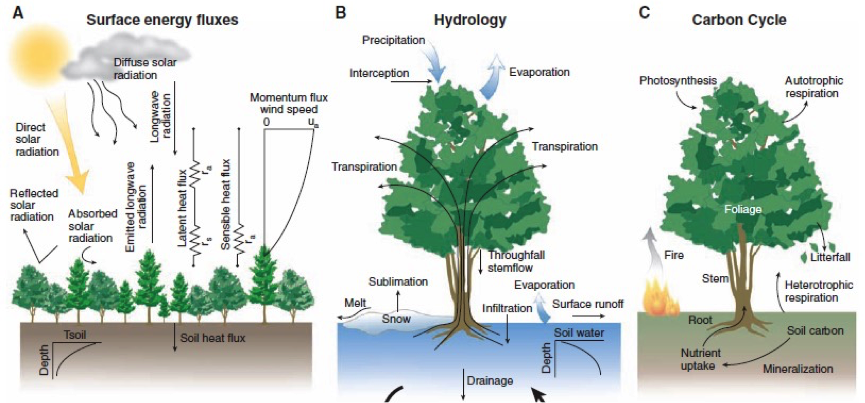About
University of Reading’s Land Surface Processes Cluster
The Earth’s land surface, which comprises rocks, soil, vegetation, water (as surface water bodies and stored in soil and rocks), snow, ice, and urban fabrics interacts with the overlying atmosphere in a number of complex ways. It is the land surface where we live, grow our crops, and let our cattle graze.
The land surface exchanges heat, momentum, water and carbon-dioxide with the atmosphere and hence plays a role in our microclimate, crop productivity, and can even affect extreme weather phenomena such as heat waves or floods. The land surface-atmosphere interactions can be summarised via the land surface energy-, water- and carbon balance (see Fig. 1), and related key processes, variables and parameters; it is these that are studied by members of the Land Surface Processes Cluster.

Figure 1: Fluxes in the Surface Energy-, Water- and Carbon balance. Figure source: Bonan, G.B. Science, 320,1444-1449 (2008)
The purpose of the Land Surface Processes Cluster is to better exploit existing expertise, data and tools within the University of Reading and its collaborator Institutions to study land surface processes spanning a wide range of spatial and temporal scales, using both observations (in-situ and remote sensing) and modelling. For the latter, we help develop, test, and exploit both off-line Land Surface Models (LSMs), such as JULES and CTessel, and LSMs coupled to Numerical Weather Prediction (NWP) or Global Climate Models (GCMs). We also work with specialised models that facilitate research into the relationships between optical and thermal remote sensing and land surface processes (photosynthesis and energy balance fluxes), such as the SCOPE model, and with water balance-crop productivity models such as SWAP (Soil Water Atmosphere Plant).
The Met-land mailing list is set up to share information among the land surface processes group members and to arrange the group meetings. To subscribe, first follow this link and register yourself at https://maillists.reading.ac.uk/scripts/wa-READING.exe?GETPW1=&X=&Y=
After that, wait at least 10 minutes for the email for confirming the registration, and then follow this link to subscribe to the list: https://maillists.reading.ac.uk/scripts/wa-READING.exe?SUBED1=MET-LAND.
CREDIT: Banner image shows the net primary productivity during the month of December 1999. (Image by Robert Simmon, NASA Earth Observatory, based on data provided by the University of Montana NTSG)
